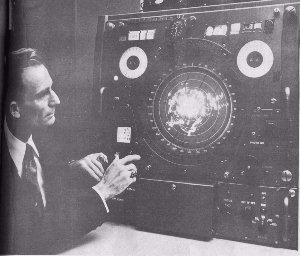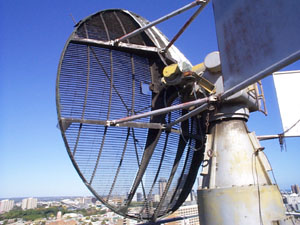The antenna was installed on top of the Redmond Barry Building at the University
of Melbourne. "The equipment making up the radar head had to be lifted up the
200ft face of the Redmond Barry Building and large sections of the roof structure
removed and redesigned."(1) The Transmitter-Receiver,
Tracking and Control units and Link equipment were also in the tower of the
building. Control and Display Units were situated both at the Radar Laboratory
in the Redmond Barry Building and at the Victorian Regional office in Latrobe
Street. Lines between the radar Head and the Regional office were provided by
P.M.G. co-axial and telephone cables. Switching of the control of the radar
was done by the "DIV/UNIV" control switch at each end of the link.
The system used an analogue computer to estimate rainfall rates.
 |
| Dale Sirmans of National Severe Storms Laboratory (USA) at the RC33 PPI (Weather News Nov. 1971) |
 |
|
RC33 Antenna still finds |
The Melbourne RC33's Japanese
Brother
"In a sense the Melbourne RC33 radar was a prototype for the Mt Fuji radar.
It had a bigger dish but the same mercury vapour thyratrons for the servo, parametric
amp in the receiver front end and probably the same failure prone pulse transformer".(2)
The Mt. Fuji system was installed in 1964, at an altitude of 3780 m
and provided 35 years of service.
References
(1) The Melbourne Weather Radar
- Working Paper No.84, Bureau of Meteorology, January 1965
(2) A.L.West (private communication)
(3) Weather
Radar Signal Processing- Working Paper No.136, Bureau of Meteorology, January
1971